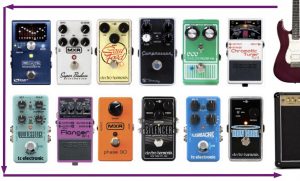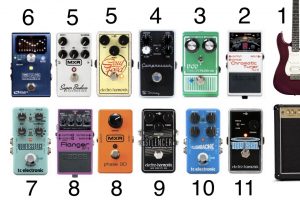Guitar Pedal Order

[responsivevoice_button]
There is a general order for guitar pedal placement however the order in which you place your pedals is truly a personal choice as the pedals must serve the purpose you intend them to serve. If the conventional order does not allow you to create the sounds you wish to create, you can change the order to suit your individual need.
The logic behind the ‘conventional’ order is determined by how pedals were meant to react to the incoming signal, how they affect the signal itself, and also how they affect to outgoing signal. This does not mean that there is only one correct way to place pedals however there is a general expectation for their placement based on what they were created for.
That’s said, there have been many great songs where the conventional order was not respected. One great example is Eddie Van Halen’s setup for Ain’t talkin’’bout love where the Phaser (a modulation effect) as well as an Echo (delay) pedal are placed prior to distortion, or in Eddie’s case, before an overdriven/distorted amplifier.
Pedals that rely on dynamics for example would not be used best if they follow a signal that has no dynamics therefore the rule of thumb would be for pedals that require dynamics to be as early in the chain as possible so that they receive a direct guitar signal, and therefore the full dynamics of a riff, followed by pedals that may tame the dynamics.
Here is the conventional order of pedals to get you started however feel free to experiment with orders, especially for pedals that belong to the same category:

1. Your guitar.
2. Tuners can be placed anywhere in the signal chain however they are best placed first so it receives a clean, unprocessed signal.
3. Filters: Wah pedals, auto-wahs, envelope filters, and sometimes phasers. Basically any pedal that depends on dynamics.
4. Compressors: Post-Dynamics to help even out the dynamics, and provide a smoother, consistent tone for the rest of the effects in the chain.
5. Distortion/Overdrive/Fuzz.
6. EQ and/or boost pedals.
7. Pitch-shifting: These pedals work best with compressed signals.
8. Modulation: Choruses, Flangers, and (sometimes) Phasers.
9. Volume pedals, noise gates, limiters, and tremolos.
10. Delays.
11. Reverbs.
12. Your amplifier.